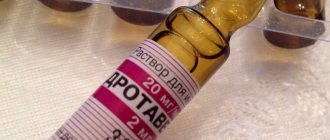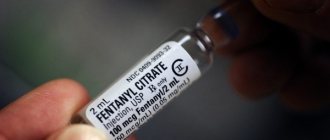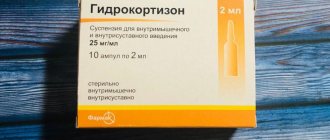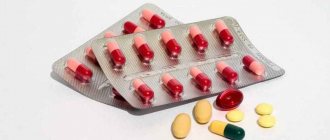pharmachologic effect
Eufillin (intravenously and for intramuscular administration) has a diuretic, antispasmodic, tocolytic and bronchodilator effect on the body. The injection solution helps with pathologies accompanied by obstruction of the respiratory tract. Intramuscular aminophylline can be considered a medicine for systemic use.
The principle of action of Eufillin in ampoules is based on the ability of the drug to block adenosine (purine) receptors of bronchial cells and accelerate the accumulation of cyclic adenosine monophosphate in them. With regular use, there is a decrease in the rate of entry of calcium ions through the channels of cell membranes and a decrease in muscle contractile activity.
Therapeutic effect of Eufillin:
- improvement of alveolar ventilation;
- stimulation of breathing;
- increased sensitivity of the respiratory center;
- improving the activity of the respiratory and intercostal muscles;
- increase in mucociliary coefficient;
- stimulation of diaphragm contractions;
- relaxation of the bronchi.
The drug can be used for apnea: the medication normalizes breathing, provides an influx of oxygen and reduces the concentration of carbon dioxide. The medication is able to stimulate the activity of the heart muscle, normalizing the frequency of its contractions. Accelerates blood microcirculation, reduces tension in the walls of blood vessels.
Diuretic properties manifest themselves as an increase in the volume of blood flow in the kidneys. Eufillin in ampoules dilates the bile ducts, improves the rheological properties of blood and minimizes the risk of blood clots. The tocolytic effect manifests itself in the form of a decrease in contractility and excitability of the myometrium. When using Eufillin in high doses, an epileptogenic effect is observed.
When it enters the systemic circulation, the active component is 60% bound to plasma proteins. Metabolism is carried out by the liver. The half-life is 3-6 hours. Excreted by the kidneys or intestines (partially).
Properties of the drug
Why is aminophylline prescribed? This medicine belongs to the xanthine “family”. It is often prescribed for bronchitis, severe cough, COPD (even in later stages), as the drug significantly improves the functioning of the respiratory system. After administration, the bronchi dilate. The pharmacological action of the drug has a beneficial effect on the muscles of the organ, relaxes them and thereby eliminates spasms.
The functioning of tissues improves, due to which the contractility of the intercostal and diaphragmatic respiratory muscle structure is normalized. After some time, pulmonary ventilation stabilizes, and the level of carbon dioxide in the blood decreases.
According to the instructions, the drug helps stimulate cardiac activity. Against this background, the strength of myocardial contractions and their frequency increase. The tone of the vascular system of the skin, brain and kidneys decreases as well as the pressure in the pulmonary circulation.
Cyclic adenosine monophosphate accumulates in epithelia. Cells are less filled with calcium ions, on which muscle contraction depends. This mechanism helps to relax the muscles.
Diuresis may also increase, since the drug improves the blood supply to the kidneys and has a diuretic effect. Red blood cells become stronger and therefore less susceptible to various types of damage.
It also has a beneficial effect on the gastrointestinal tract. The components are well absorbed, due to which the medicinal substances reach the intended place in the required quantity. But if you take the product with food, absorption slows down.
These properties are primarily due to theophylline, and the antispasmodic effect is enhanced by ethylenedamine. The medicine also dissolves easily in water. The advantage of the drug is that it can be administered intramuscularly or intravenously. Excretion from the body occurs along with urine.
Indications and contraindications for use
The instructions included in each box of Euphyllin contain possible contraindications and indications for use. The medication is prescribed for the following pathologies:
- left ventricular failure (bronchospasm, Cheyne-Stokes type breathing);
- prolonged migraines;
- pulmonary hypertension;
- cerebrovascular insufficiency of the brain;
- broncho-obstructive syndrome due to emphysema, cardiac asthma or bronchitis.
The main contraindications are:
- severe liver and kidney diseases;
- sepsis;
- porphyria;
- hyperthyroidism;
- thyrotoxicosis;
- uncontrolled hypothyroidism;
- gastroesophageal reflux;
- increased threshold of convulsive readiness;
- epileptic seizures;
- ulcerative lesions of the stomach and duodenum (in the acute stage);
- hemorrhages in the retina;
- bleeding (history of gastric, intestinal);
- hemorrhagic stroke;
- vascular atherosclerosis;
- pulmonary edema;
- severe arterial hypertension;
- paroxysmal hypotension;
- tachycardia;
- extrasystole;
- angina pectoris;
- myocardial infarction;
- acute heart failure;
- individual intolerance to the active ingredient or additives.
The high risk of side effects makes it impossible to use Eufillin in children under 14 years of age. Lactation and pregnancy are considered relative contraindications. For children under 3 years of age, the solution is not administered into a vein. Droppers with Eufillin for osteochondrosis dilate blood vessels, helping to relieve a pain attack. Regardless of the form of release, the drug can be taken for bronchial asthma.
Eufillin during pregnancy
Eufillin is prescribed to pregnant women for health reasons in the absence of a threat to the life of the mother and child. According to reviews, a pregnant woman's heart rate increases, dizziness and weakness appear.
Children who are in the womb of a mother who was prescribed Eufillin in the last trimester should be under medical supervision for the first 28-30 days after birth. In gynecology, the drug is used for edema, placental insufficiency and gestosis as part of complex therapy. There is no clear treatment regimen; the attending physician selects the dosage individually.
Use during pregnancy
It is allowed when the benefits of the medicine outweigh the potential risks for the expectant mother and fetus. It can only be used with the permission of a doctor. In most cases, the course lasts only a few days.
Pregnant patients are recommended to take medication to eliminate severe edema and normalize kidney function. It also relaxes the smooth muscles of the uterus. The drug is contraindicated in women in the early stages, with heart disease or a tendency to systematically lower blood pressure (hypotension).
Eufillin: instructions for use in ampoules
Many people are interested in the question of whether the drug can be taken in ampoules. Experts do not recommend taking the solution orally. Eufillin can be administered intramuscularly and intravenously. The medication may be present in microenemas and inhalation solution.
Intramuscular injection
No more than 1 ml of the drug is administered intramuscularly to the patient once. The tip of the ampoule is carefully broken off, the solution is drawn into a sterile syringe and excess air is released. For injections, thick and long needles are considered the most suitable: thin ones are difficult to remove from the muscle, they constantly slide off the holder. The drug is injected into the upper corner of the buttock. The injection of Eufillin is painful; discomfort can persist for several hours. A hematoma often forms at the injection site. The medicine is not administered subcutaneously.
Intravenous administration
Intravenous administration ensures faster absorption of the active ingredient. Patients in serious condition are given a single loading dose of the drug: up to 5.5 mg/kg. To prepare a dropper, up to 20 ml of Eufillin is injected into a solution of sodium chloride (0.9%, 15-20 ml). The resulting mixture is poured into the remaining saline solution (up to 500 ml), drip administration is carried out for 30-40 minutes.
Status asthmaticus requires intravenous administration of up to 720 mg of aminophylline. The daily norm is no more than 0.5 ml/kg. For an adult patient, a single patient dose (provided that the solution is injected into a vein) is 6-7 mg/kg. The drug must be diluted with sodium chloride. The duration of the jet injection is 2-4 minutes.
Adolescents are prescribed medication at a dose of 16 mg/kg per day. It is advisable to divide the therapeutic norm into several administrations. If necessary, it can be increased with the permission of a specialist. The course of treatment is 10-14 days.
Administration by probe
For newborn children in serious condition, the drug is administered through a nasogastric tube. A narrow bore catheter is passed through the nasal cavity into the stomach. A Levine catheter is most often used to administer the drug. The probe is installed by an appropriately qualified medical professional. The dosage regimen is selected by the pediatrician.
Microclysters
You can prepare a microenema with Eufillin yourself, at home. To do this, you need to take 0.5 mg of the drug and dissolve it in 20 ml of boiled water at room temperature. The prepared solution is drawn into a rubber bulb (the tip is disinfected in advance) and administered rectally. The procedure is repeated every 3-4 hours. Enemas are contraindicated in children under 16 years of age.
Electrophoresis
Electrophoresis using the drug is prescribed for adults suffering from osteochondrosis and arthritis. For children, the procedure is prescribed for dysplasia or to relieve intracranial pressure. Electrophoresis allows you to achieve the desired concentration of the main component in the affected tissues.
The medication has a targeted effect, so systemic side effects rarely occur. Electrophoresis is prescribed to newborn children over 30 days old. A napkin soaked in the solution is placed on the sore spot and the electrodes are secured. The duration of the procedure does not exceed 15 minutes, during which time the medicine penetrates into the affected areas. The course of treatment is 8-10 sessions.
To restore the functional activity of internal organs after birth injuries, newborns undergo Ratner electrophoresis. The child is given 2 napkins soaked in different medications: 1 - aminophylline solution (on the cervical vertebrae), 2 - papaverine solution (on the ribs). Current strength: no more than 2 mA. Duration: 15 minutes. The procedure has virtually no contraindications, except for skin diseases, arterial hypertension, arrhythmia and heart failure.
Inhalations
Inhalations with Eufillin are prescribed to adults and children for bronchial obstruction and dry cough. The active component quickly penetrates the systemic bloodstream and reaches the affected organ. The procedure is carried out using a special device - a nebulizer. Eufillin diluted in warm water is poured into a special compartment. The released vapors must be inhaled for 10 minutes. The procedure is repeated 2 times a day.
conclusions
To summarize, I would like to say that, despite such a long existence of aminophylline in pharmacology, the demand for it has not decreased. It is a strong medicine and is often used to relieve emergency conditions, as it gives a very good result. But in addition to injections, it is also used in tablets, electrophoresis is performed with liquid (in neurology for osteochondrosis and various diseases of the spine), and inhalations are made using a nebulizer. When taking it, you should adhere to the doctor’s prescriptions and do not adjust the dose and duration of the course yourself, since this medication has a number of severe side effects for the body, and this can cause many problems.
Side effects and overdose
Side effects occur when the dosage regimen is incorrectly selected. These include:
- tachypnea;
- chest pain;
- flushed face;
- increased sweating;
- hematuria;
- frequent urge to urinate;
- albuminuria;
- hypoglycemia;
- fever;
- rashes on the skin;
- itching;
- loss of appetite;
- change in taste preferences;
- exacerbation of ulcers;
- uncontrollable vomiting;
- heartburn;
- pain in the epigastric region;
- diarrhea;
- attacks of nausea;
- uncontrolled angina pectoris;
- decreased blood pressure;
- cardialgia;
- cardiopalmus;
- arrhythmia;
- sleep disorders (drowsiness/insomnia);
- tremor;
- psycho-emotional overexcitation (anxiety, aggression, irritability);
- dizziness;
- headache.
Ailments are often dose-dependent, so experts recommend that if side effects occur, adjust the dosage regimen downward.
Symptoms of overdose develop with a multiple increase in the daily dose. The characteristic features are:
- convulsions, sensitivity to light or sound;
- tremor;
- arrhythmia;
- overexcitement;
- hyperemia of the skin;
- uncontrollable vomiting;
- prolonged diarrhea.
Eufillin does not have a specific antidote. A patient who experiences symptoms of overdose must be taken to the nearest medical facility: gastric lavage and taking enterosorbents will not help in this case. Removal of toxins is carried out by enhancing the processes of natural detoxification (formed diuresis).
If the dose introduced into the body exceeds 0.5 mg/ml, then the patient is provided with respiratory support (artificial ventilation), hemodialysis, hemosorption and plasmapheresis are performed. A physician should monitor hemodynamic parameters. If the patient experiences convulsions, Diazepam is administered intramuscularly. Barbiturates are strictly prohibited.
Nuances of efficiency
Intended for intravenous administration, "Eufillin" allows you to stabilize the activity of the respiratory system, thereby leveling excess reactivity, if associated with inhalation of allergens. The effect of the drug is observed at a late stage of the body’s response to the penetration of the stimulus. At the moment, it is not possible to clarify in detail which mechanism ensures the effectiveness of the drug. Scientists have found that it is associated with inhibition of PDE and is not due to inhibition of adenosine activity. Some tests and studies have shown that under the influence of aminophylline, the content of T-suppressors in the peripheral circulatory system increases. At the same time, such cellular structures become more active.
In the accompanying instructions for Eufillin injections, the manufacturer indicates the fact that mucociliary clearance increases under the influence of the active component. At the same time, the drug causes diaphragm contractions and stabilizes the functionality of the muscular system of the respiratory organs and ribs. The substance activates the respiratory center and makes it more susceptible to carbon dioxide. It has been established that the medication can improve the quality of ventilation at the level of the alveoli. As a result, the severity of each new episode of apnea decreases and the frequency of such events decreases. Under the influence of the medication, respiratory function is stabilized, the blood is more effectively filled with oxygen molecules, and the concentration of carbon dioxide will drop. "Eufillin" helps to activate pulmonary ventilation when there is a lack of potassium in the body.
special instructions
A toxic effect develops if the concentration of the main component in the blood reaches 0.03 mg/ml. Eufillin has a stimulating effect on the respiratory system only if the content of the substance in the blood does not exceed 0.01 mg/ml. Children under 3 years of age and elderly patients require careful use; medication for this category of patients is prescribed as a last resort.
The drug can be used in geriatrics: it is prescribed in minimal doses. During the treatment period, experts recommend completely avoiding drinks containing caffeine and taurine. Chocolate and strong black hare should be excluded from the diet. Before injection, you need to hold the syringe with the solution in your hands for a little while so that it warms up.
Alcohol compatibility
The drug has negative compatibility with alcohol. Before starting treatment, the patient is instructed to completely stop drinking drinks that contain ethanol.
Interaction with other drugs
Beta-blockers, caffeine, ephedrine and Furosemide can enhance the effect of Eufillin, so these components are rarely combined. The therapeutic activity of the drug is reduced by Carbamazepine, Sulfinpyrazone, Rifampicin, Isoniazid, Phenobarbital and Phenytoin, so the dose of the bronchodilator is increased. In patients who smoke more than 15-20 cigarettes per day, accelerated metabolism of Eufillin is observed.
With the simultaneous use of antiviral medications, beta-blockers, Disulfiram, Fluvoxamine, Viloxazin, Lincomycin, Cimetidine, Isoprenaline, Allopurine, macrolide antibiotics with Euphyllin, the therapeutic dose of the latter should be increased. If the patient is prescribed a bronchodilator in combination with fluoroquinolone antibiotics, the dose of Eufillin is reduced by 25%.
Hypoglycemia develops with the combined use of diuretics, glucocorticosteroids and medications with a bronchodilator effect. Eufillin enhances the therapeutic effect of anticoagulants. Solutions of levulose, glucose and fructose are incompatible with the medication. The drug can only be diluted with sodium chloride.
Interaction with other drugs
Increases the risk of undesirable effects of hormonal drugs (dexamethasone, cortisol), mineralocorticoids (sodium levels increase).- There is a potential for life-threatening ventricular arrhythmias when combined with medications for general anesthesia.
- Able to prolong the effect of beta blockers and diuretics.
- Increases the toxic effect of drugs that excite the nervous system.
- When taking rifampicin, phenobarbital, phenytoin, isoniazid, carbamazepine, sulfinpyrazone, jazz, it is worth increasing the dose of aminophylline, since the above drugs contribute to its elimination.
- When combined with macrolides, lincomycin, allopurinol, fluoroquinolones, methotrexate, propafenone, verapamil, the effect of the medication is enhanced, so you should be careful and reduce the dose.
- Do not use with xanthines.
Analogs (briefly)
The drug has several generics with similar therapeutic effects. These include:
- Theotard. Available in capsule form. The composition contains theophylline, a xanthine derivative. It has a bronchodilator effect, quickly eliminating obstruction of the bronchial canals. Cost - 180-195 rubles.
- Teopek. Release form: tablets. The main component is a phosphodiesterase inhibitor, a purine derivative. Due to the ability of the medication to have a vasodilating effect, blood flow in the kidneys increases, and the smooth muscles of the bronchi relax. Price - from 200 rub.
- Aerophyllin. The active ingredient is doxophylline. The drug is marketed in tablet form. The antispasmodic can have a bronchodilator effect. The contractile function of bronchial smooth muscle tissue decreases with systematic use. Cost - 122 rubles.
- Neophylline. Extended-release tablets contain theophylline. A bronchodilator is able to improve the functional activity of the respiratory and intercostal muscles. Price - 55 rub.
The drugs are in different price categories. Each of them has a number of contraindications, so medications are prescribed by a doctor after a detailed examination. Independent choice of medication is strictly prohibited.
Technical information
The Eufillin solution is made transparent. The liquid is colorless or may be very lightly colored. The presence of solid elements is not allowed, there should be no sediment or flakes. The manufacturer indicates in the accompanying documentation the need to sell Eufillin only if the patient has an official prescription issued by a doctor, confirmed by stamps. "Eufillin" is presented for sale in cardboard boxes containing a dozen 10 ml ampoules. And in each such ampoule, in addition to the auxiliary ingredients, there is 25 mg of the active substance.
According to the instructions accompanying the ampoule, “Eufillin” is produced using aminophylline. It is this compound that is the main substance that guarantees the bronchodilator effect. Specially prepared and purified water is included as an auxiliary compound. The level of its processing is deep enough that this liquid can be injected into the body without fear. "Eufillin" belongs to the category of phosphodiesterase inhibitory drugs. This is a bronchodilator.
Kinetics
The manufacturer describes the reactions occurring in the body after using the drug intramuscularly in the instructions for use of Eufillin. Ampoules must be equipped with such a document. It clarifies the fact that aminophylline, upon entering the human body, soon enters into transformation processes if the acidity level is average, inherent in the human body. During the interaction, theophylline is released. Bronchodilating properties can be observed when the concentration of this compound in the circulatory system reaches 10-20 μg/ml. If the content exceeds 20 units, the drug has a toxic effect and can be regarded as a toxin. The center responsible for respiration is excited when the active ingredient is contained in the circulatory system in an amount of 5-10 units.
The instructions for use accompanying the Eufillin ampoule clarify the ability of theophylline to form strong bonds with whey proteins. On average, about 40% of the received dose enters into such reactions. In the presence of any pathologies, as well as in infancy, the binding rate is observed to be lower. In adults, protein binding can reach 60%, while in infants it is no more than 36%. If hepatic cirrhosis is detected, on average, approximately 36% of theophylline is bound to plasma proteins. The active compound is able to penetrate the placenta barrier. The plasma concentration inherent in the fetus is slightly higher than that observed in the mother's body. Theophylline is found in milk secreted by women's mammary glands.
Pharmacokinetics: continuing consideration
The manufacturer, in the instructions for use accompanying the Eufillin ampoules, specifies: theophylline is processed by liver cells. The process occurs with the involvement of cytochrome isoenzymes. The most significant is CYP1A2. The transformation is accompanied by the generation of trimethylxanthine and a number of acids. All reaction products are eliminated by urine. In its original form, no more than one tenth of the dose taken is excreted from the body of an adult patient. In infants, an impressive percentage is eliminated as caffeine, since the internal systems responsible for processing it have not yet been formed. In its original form, about half of the dose used is eliminated from the body.
The half-life of asthmatics who are not addicted to smoking is estimated at 6-12 hours, if there are no pronounced pathological processes in other organs. For smokers, the period is reduced to 4-5 hours, for children the parameter is estimated at an hour to five hours, and for infants and premature births it varies between 10-45 hours. The half-life becomes longer in the elderly, as well as in patients suffering from cardiac insufficiency. The duration may increase due to liver diseases. Clearance becomes less with liver failure and pulmonary edema, COPD. Its decrease can be caused by chronic dependence on alcohol and heart failure. Ethylenediamine does not adjust the kinetic parameters of theophylline.
Undesirable effects
The possibility of such is indicated by the instructions accompanying the Eufillina tablets and ampoules. Injections of this drug are more likely to cause side effects if the medication is administered unreasonably quickly. Some people experience heart pain and low blood pressure. This is also possible in the fetus if the drug is used by a pregnant woman. Under the influence of the drug, headaches and dizziness may occur; some people experience sleep disturbances and anxiety. May vomit and feel sick, there is a risk of heartburn and ulcers, bowel dysfunction. Some people have increased levels of albumin and blood in their urine. There is a possibility of allergies, manifested in the form of skin rashes and fever.
Occasionally, taking the drug is accompanied by hypoglycemia. The instructions for using Eufillin, which describe the features of intramuscular and intravenous administration, warn of the possibility of a local reaction. In the area where the drug is administered, the skin may become red, increase its density, and feel pain. Occasionally, tachypnea is observed. Some complained of hot flashes, chest pain, increased urine output, and excessive activity of the sweat glands.
Patient Experience
Reviews and instructions for use of Eufillin indicate that the product really helps asthmatics well. As can be seen from open sources, opinions in general about the effectiveness and balance of the drug are positive, and the average rating on a five-point scale exceeds 4.5 points, which indicates the high quality of the product. People who used the drug admit that they sometimes encountered side effects, but they were relatively insignificant against the backdrop of the positive features of the therapeutic course.
As noted in the instructions for use of Eufillin, injections of this drug can cause anorexia. From the reviews you can see that some use the product to get rid of extra pounds. Although this use cannot be called correct, in general it rarely harms the body, as people who took aminophylline in this way believe. Doctors, however, do not recommend injecting this drug as part of the fight against excess weight, since the risk of side effects is increased.
People who have used the drug note its affordable price. Many believe that the cost-quality ratio for Eufillin is exceptionally good, therefore, among similar pharmaceutical products, this one is the best.










